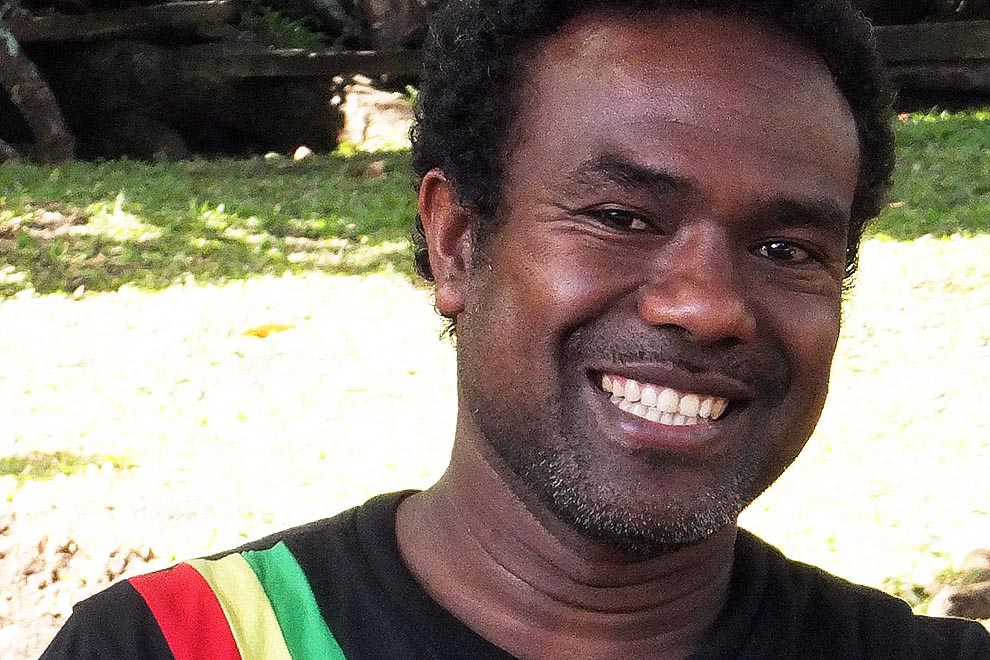“We have a whole mix of people in the Community Disaster Committee – old, young, mamas and chiefs,” Sampson Shipa told me last year. “Within our committee, we have different jobs. We have people responsible for communications or logistics. We also allocate tasks such as garden coordinator, or first aid training or information.”
I had joined NGO workers on a trip to Futuna, a small volcanic island in the southeast of Vanuatu. Shipa, chair of the Community Disaster Committee on an island of just 600 people, was showing us how local villagers had managed to build community resilience to prepare for climate change and natural disasters.
Since last weekend’s Cyclone Pam devastated much of the country, I haven’t been able to get through to people on Futuna. There’s only one mobile phone tower near the island’s grass airstrip, and I suspect it’s been hammered by gale-force winds, like much of the infrastructure across the country.
As we walked around the island’s rocky tracks last year, visiting each of six villages clustered on the coastline, villagers proudly displayed their work: pilot gardens, water supply systems, trials for food drying and preservation, information noticeboards. These initiatives showed a level of commitment and preparedness that belies the image of starving, helpless islanders presented in much of the media in the aftermath of Cyclone Pam.
Across the island, experiments were under way to find the best way to preserve “cyclone foods” and maintain food supplies after natural disasters. Villagers traditionally gather bananas, wrap them in banana leaves and bury them to eat when village gardens are being re-established after a cyclone. On Futuna, people were seeing whether concrete pits could be used to better preserve cyclone foods, reducing the labour involved in constantly replacing rotting leaves in an earth pit.
The villagers were also testing other ways of maintaining food and water supplies. These techniques are valuable not only after natural disasters but also in the lean periods that will come with changing rainfall linked to long-term climate change. One of the innovative features of this process is the mobilisation of both older and younger members of the community, combining experience and enthusiasm, and drawing on traditional knowledge as well as new technologies.
Despite this preparedness, the sheer scale of category-5 Cyclone Pam requires an urgent response from the community. The Australian government has immediately deployed aid workers, technical specialists and Hercules aircraft to ferry supplies. But this response comes at a time when the government has announced massive cuts to Australia’s aid program in coming years, and has slashed the budgets of key Australian institutions – from Radio Australia to the Australian Bureau of Meteorology – that play a crucial role in disaster preparedness.
It also comes at a time when science is telling us that the devastation of Cyclone Pam is a sign of things to come.
Cyclone Pam’s most extensive damage was in Vanuatu, but other small island nations were also hit severely. Tuvalu prime minister Enele Sopoaga said that 45 per cent of his country’s population has been affected by Cyclone Pam, which has also reached Fiji, Kiribati, Solomon Islands and New Caledonia. In the outer islands of Tuvalu, the entire population of 400 people were evacuated from Nanumaga due to flooding caused by Cyclone Pam, together with another eighty-five families from Nukulaelae. On the island of Nui, fresh water supplies were contaminated after the island was covered by a large storm surge, while Vaitupu and Nukufetau were both badly affected by flooding.
The Regional Specialised Meteorological Centre in Fiji has already chosen the names for the next cyclones that will develop in the region. Pam will be followed in coming months and years by Reuben, Solo, Tuni, Ula, Victor and Winston – then, not too far in the future, we’ll start the alphabet again.
Because of its location, Vanuatu faces particular hazards from cyclones, volcanoes and earthquakes. In the latest World Risk Report, Vanuatu was listed as the globe’s most at-risk country in terms of exposure and vulnerability to hazards. Data from recent scientific studies by the CSIRO and Bureau of Meteorology show that Vanuatu is experiencing significant changes in weather. Longer-term projections show a range of potentially adverse impacts, including rising sea levels, increasing sea surface temperature, changes to wind-driven waves, and less frequent but more severe tropical cyclones.
As more people and community infrastructure are exposed to climate shocks and disasters, decades of hard‐won development could be reversed. Whether they’re called hurricanes, cyclones or typhoons, these natural disasters have set back economic and social development in countries across the Asia-Pacific region, from Typhoon Haiyan in the Philippines to Cyclone Ian in Tonga. Over 7000 people were killed in the Philippines in late 2013, and last year Cyclone Ian displaced 70 per cent of the population of Tonga’s northern Ha’apai islands. (Ha’apai was already under drought conditions, and the Kingdom had to ship in food and water supplies.)
Climate change has so stacked the deck that this kind of disaster is likely to occur with greater intensity. Storm surges move further inland on sea levels that have risen over the last century, amplifying damage to infrastructure and coastal communities. (Satellite data indicate the sea level near Vanuatu has risen by about 6 mm per year since 1993, more than the global average of 2.8–3.6 mm per year.)
The Intergovernmental Panel on Climate Change and a range of scientific agencies have developed projections of cyclone activity that suggest a decrease in the frequency of cyclones by the late twenty-first century but an increase in the severity of these events. A 2010 collaborative study published in Nature Geoscience notes that “future projections based on theory and high-resolution dynamical models consistently indicate that greenhouse warming will cause the globally averaged intensity of tropical cyclones to shift towards stronger storms, with intensity increases of 2–11 per cent by 2100.”
The warming of the oceans can also contribute to the severity of storms. “Once [cyclones] do form, they get most of their energy from the surface waters of the ocean,” observes professor Will Steffen from the Australian National University. “We know sea surface temperatures are warming pretty much around the planet, so that’s a pretty direct influence of climate change on the nature of the storm.”
As Kevin Trenberth, an expert in climate change and extreme weather at the US National Center for Atmospheric Research, notes, “In the large area around Vanuatu the sea surface temperatures were one to two degrees Celsius above normal… So the atmosphere all around there has some 10 to 20 per cent more moisture in it, than a comparable storm in the 1970s would have had.”
Ironically, the devastation of Cyclone Pam coincided with the third UN World Conference on Disaster Risk Reduction, in the Japanese city of Sendai. There, standing before the conference, French foreign minister Laurent Fabius said that 70 per cent of natural disasters are now linked to climate change, twice as many as twenty years ago. With France due to host crucial climate negotiations in Paris next December, he stressed that disaster risk reduction and action on climate change went hand in hand.
This integration of climate change and disaster response is well under way across the Pacific islands. Since 2012, island governments have been developing a regional Strategy for Disaster and Climate Resilient Development in the Pacific. The strategy will merge two existing regional frameworks on climate adaptation and disaster risk reduction into one coordinated program.
Vanuatu is at the forefront of this process. In April 2013, the national government integrated a number of departments to create the Ministry for Climate Change Adaptation, Meteorology, Geo-Hazards, Environment, Energy and Disaster Management. This ministry now hosts the Vanuatu Meteorology and Geo-Hazards Department and the National Disaster Management Office in a newly constructed complex in Port Vila.
Local and NGOs, the Red Cross movement and UN agencies are also coordinating their operations to work more effectively with the government on disaster preparedness and response. Established in 2011, the Vanuatu Humanitarian Team has promoted an innovative team-work approach to improve collaboration among NGOs.
Coordinated by Oxfam and initially funded by the European Community Humanitarian Aid Office, the team includes the Vanuatu Association of Non-Government Organisations and the Vanuatu Rural Development and Training Centre Association, alongside NGOs such as Oxfam, Save the Children, World Vision and CARE. Also participating are the Vanuatu Red Cross, French Red Cross and key UN agencies (UNICEF, the World Health Organization, and the Office for the Coordination of Humanitarian Affairs). With NGO staff sitting inside the National Disaster Management Office, coordination has improved since two cyclones hit Vanuatu in 2011, and an NDMO Cyclone Support Plan is released each year.
As people overseas dip into their wallets in response to disasters like Cyclone Pam, some are worried that their donations will go on administration rather than directly helping affected communities. The Vanuatu Humanitarian Team is an important example of a cost-effective program designed to encourage coordination between different development players. For a relatively small investment, government and NGOs work together to build resilience in local communities in the lead-up to disasters. This work doesn’t hit the headlines like the immediate post-disaster flurry of activity, but is essential for communities that cannot receive assistance in the days immediately after a catastrophe.
The work of NGOs on the ground is also vital for engaging the most vulnerable members of the community. After two tropical cyclones hit Tafea Province in Vanuatu in 2011, for example, the Tanna Women’s Counselling Centre reported a 300 per cent increase in new domestic violence cases. Programs targeted at women and children are a crucial element of disaster response, as families struggle with the stress and trauma of re-establishing their homes, gardens and workplaces, at the same time as jobs disappear. (Many ni-Vanuatu work in the tourism sector, but will earn no income until hotels, bungalows and other tourist infrastructure are refurbished.)
Beyond the Vanuatu Humanitarian Team, similar work on coordination is under way to promote adaptation to climate change. In 2012, an NGO consortium in Vanuatu secured Australian government funding for climate adaptation and resilience activities. Over two and a half years, the Yumi stap redi long klimaet jenis program focused on building community resilience through livelihood initiatives in agriculture, water supply and health, and through engaging women in decision-making. Consortium members collaborated on innovative community education programs such as Klaod Nasara, which produced simple animations to explain the science of El Niño, La Niña and climate variability.
The initial core funding of $2 million for the Yumi stap redi program came from Australia’s International Climate Change Adaptation Initiative, or ICCAI, and the first phase ran until December 2014 in nine local communities across four provinces. After the Coalition took government in Canberra, the ICCAI was dropped from the Australian aid program and the consortium, focused on building community resilience and climate adaptation, was unable to draw on Australian aid to develop a new phase of activities in 2015.
The Australian government has responded immediately to Cyclone Pam, deploying Australian Defence Force aircraft with humanitarian supplies, sending technical and medical teams and announcing a $5 million package for the Red Cross, NGOs and other humanitarian organisations. The massive task of reconstruction in Vanuatu and other Pacific countries will rely on support as well as local resilience in coming months and years.
But this response to yet another natural disaster in the Pacific comes after successive Australian governments have abandoned support for an increase in Official Development Assistance.
Before the September 2013 elections, both the Labor Party and the Coalition pledged support for an increase in Australian aid to 0.5 per cent of Gross National Income, or GNI, by 2015. That objective started slipping under the Gillard government, with the target date set back to 2016–17. As well as reopening detention centres for asylum seekers on Manus and Nauru, the Labor government reallocated $375 million from the overseas aid budget towards the domestic costs of processing refugees in Australia.
Since coming to power, the Coalition government has abandoned the objective of increasing the aid budget to 0.5 per cent of GNI. On 18 January 2014, halfway through the 2013–14 financial year, the Abbott government announced cuts of $650 million to the aid budget. Specific reductions were made to regional programs in the Pacific, bilateral programs with Pacific island countries, and support for multilateral organisations. Small island states saw their allocation cut by almost 30 per cent relative to the original 2013–14 budget (Vanuatu’s allocation fell by nearly $6 million, while over $20 million was cut from Pacific regional programs, reduced from $196 million to $172.6 million).
In the May 2014 budget, Australia’s aid program suffered a further hit, with $7.6 billion cut from planned aid increases over four years. In the December 2014 Mid-Year Economic and Fiscal Outlook, treasurer Joe Hockey announced another cut of $3.7 billion, on top of the reduction in the May budget. The Pacific region has fared better than other programs in Africa and Latin America, but the loss of more than $11 billion over the next few years will inevitably constrain bilateral and regional initiatives.
Beyond this, other government cutbacks will affect the capacity of Pacific countries to develop long-term resilience to respond to disasters.
Last year, when I visited the village of Matangi – one of Futuna’s more isolated communities – people highlighted the importance of Radio Australia.
“We rely a lot on Radio Australia when there’s a cyclone coming,” said Miranda Natuifi, a young mother who is a member of Futuna’s Community Disaster Committee. “We have no telephone on this side of the island and we often can’t hear Radio Vanuatu.”
Isolated rural communities across Melanesia rely on shortwave radio transmissions, yet ABC management is debating the shutdown of these services, following the recommendations of the Lewis review into the ABC and SBS. Deep cuts to Radio Australia in 2014 saw the sacking of dozens of staff (including the Pacific correspondents for Radio Australia and Australia Network TV), and reductions in English and foreign language broadcasting to the Pacific. The Tok Pisin service to Papua New Guinea, which ni-Vanuatu Bislama speakers rely on, has been reduced to two people, while just one person broadcasts in French.
Beyond this, funding cuts to key research and scientific bodies in Australia will also affect collaboration between Australian researchers and their counterparts in the Pacific on meteorology and cyclone research.
A $111.4 million reduction over four years for the CSIRO, $10 million from the Bureau of Meteorology and a further $21.7 million from environmental science programs will have an impact on regional initiatives. These agencies have collaborated with island meteorology departments through the Pacific Climate Change Science program and on initiatives to make weather predictions more usable by farmers and fishermen across the islands.
In coming weeks, the people of Vanuatu will begin to rebuild their homes and communities. The resilience of ni-Vanuatu should not be underestimated and the government of Vanuatu will have clear priorities for the future, which will set the agenda for government and NGO assistance.
Immediate humanitarian support from Vanuatu’s neighbours is crucial, but it’s also important to look forward. How many times will our Pacific island neighbours have to rebuild shattered infrastructure before governments seriously integrate the responses to climate change and disasters? Will the Coalition slash aid once again in the May budget, as it tries to balance the books? What role will Australia play as governments try to negotiate a global climate treaty in Paris this December? Surely we can do better this this. •




